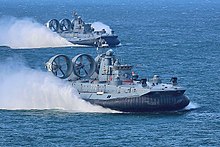Pomornik class
|
A project 1232.2 with an open bow ramp
|
||||||||||||||
|
||||||||||||||
|
||||||||||||||
|
||||||||||||||
|
||||||||||||||
|
||||||||||||||
The Project 1232.2 , with the code name "Subr" ( Russian Зубр ; for bison , NATO designation: Zubr-class LCAC ) is a class of large air cushion - landing craft of the Soviet Navy , which in the Cold War was developed and now mainly from the People's Republic China is operated.
history
The landing craft of the class were developed in the 1980s and used in the first task force in 1986. From 1985 to 1993 as well as 2001 and 2004 a total of 15 boats of the class were laid down in Saint Petersburg and Feodosia . After the end of the Soviet Union, two boats were scrapped at the shipyard before they were completed and three boats from the Black Sea fleet were handed over to Ukraine , which built another boat itself. As of 2001, three new boats were built for Greece . The unit price was just under 100 million US dollars.
Russian Navy
There are still two boats in service with the Russian Navy (as of 2007):
- 770 Yevgeny Kocheschkow (previously MDK-50, named after Yevgeny Nikolayevich Kocheschkow )
- 782 Mordovia (previously MDK-94)
Ukrainian Navy
The Ukrainian Navy originally had two boats in service. The Navy of the People's Republic of China bought two boats from the Ukraine, which were built by the Ukraine in Feodosiya as "bison class". The last boat left the shipyard in a hurry on March 1, 2014, before Russian troops seized the peninsula during the Crimean crisis . Russia later pledged to fulfill the treaty between China and Ukraine. After the Crimean crisis, Ukraine no longer had any boats of the class in service.
Greek Navy
The Greek Navy owns four boats. Kefallonia (L 180) was taken over by the Russian Navy and overhauled. Ithaki (L 181) was newly built in Ukraine from 2001 , Zakynthos (L 183) new in Russia. The fourth boat, Kerkira (L 184), was built in Ukraine from June 2004 and went into service in January 2005.
Navy of the People's Republic of China
The Navy of the People's Republic of China bought two boats in Ukraine and the right to build two more in China. Four boats were bought by Greece, making the Chinese Navy the largest active fleet in its class with six boats and the option of two more. Observers speculated that the boats could be used by China in the territorial conflict in the China Sea .
use
Due to the Soviet Baltic Sea and Black Sea strategy, the landing craft had the task of landing large quantities of vehicles and material quickly and in a targeted manner independently of the usual traffic routes, also as an ideal aid for disaster relief in coastal areas.
In addition, the boats were equipped with heavy weapons for landing support and are able to lay minefields.
The big advantage of the boats is not only the higher speed compared to normal landing craft, but also the fact that they can reach around 80% of all coasts and land troops without having to wade through the water, compared to around 17% with regular boats .
Hovercraft can also operate over ice and the beach. In this way, the classic unsafe landing zone in the surf, such as the landings in World War II , can be avoided. The troops and equipment can be transported to an inland location, with this type of obstacles up to about 2 m high can be driven over.
This concept of bringing heavy equipment directly onto the beach from the high seas over a distance of up to 80 kilometers is called OTH ( over the horizon ) and could previously only be carried out with helicopters, and only to a limited extent.
Payload
- 3 battle tanks or
- 1 T-80 main battle tank and 100 soldiers or
- 10 armored personnel carriers and 140 soldiers or
- 140 soldiers and 130 tons of cargo or
- 500 soldiers
Trivia
On August 18, 2013, the Mordovia , one of the two Russian boats, made a landing maneuver in the Russian oblast of Kaliningrad on a beach populated by bathers on the Baltic Sea near the Baltiysk district of Metschnikowo (Neuhäuser) . The beach is part of a military training area and is actually closed to bathers.
See also
literature
- Ю.В.Апальков: Корабли ВМФ СССР. Том IV - Десантные и минно-тральные корабли. Saint Petersburg, 2007, ISBN 978-5-8172-0135-2 . (Russian)
Web links
- Project 1232.2 at russianships.info (English)
- at www.naval-technology.com (English)
- www.hazegray.org (English)
Individual evidence
- ↑ "Naval Forces News - China" of March 3, 2014
- ^ "Rosoboronexport to supply to China Zubr landing craft ordered in Ukraine" TASS of July 3, 2015
- ↑ Kyle Mizokami: "China Is Buying Giant Attack Hovercraft From Russia" popularmechanics.com of September 24, 2015
- ↑ a b c Ю.В.Апальков: Корабли ВМФ СССР. Том IV - Десантные и минно-тральные корабли. Saint Petersburg, 2007, ISBN 978-5-8172-0135-2 , p. 49
- ↑ Navy ship frightens beachgoers: Full speed ahead! Spiegel Online Video, accessed August 22, 2013


